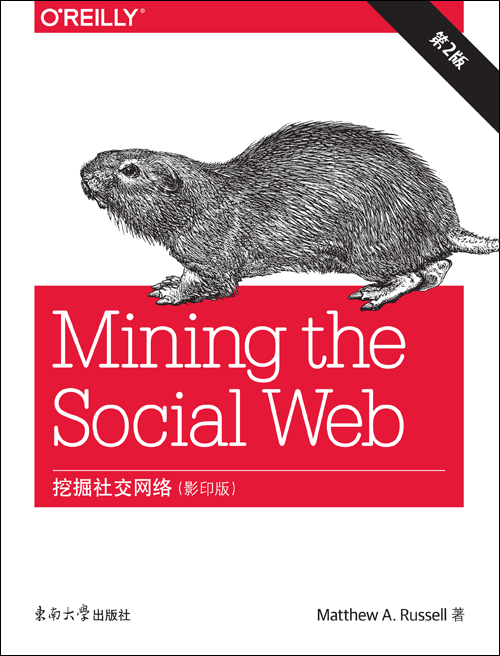挖掘社交网络(第2版,影印版)
出版时间:2014年12月
页数:448
你应该如何利用丰富的社交网络数据来发现任意两个人之间的连接,他们所交流的话题,以及他们在哪儿?通过本次扩展和彻底的修订,你将学习到如何获取、分析和总结来自于社交网络每个角落的数据,包括Facebook、Twitter、LinkedIn、Google+、 GitHub、电子邮件、网站和博客。
· 利用IPython Notebook、Natural Language Toolkit、NetworkX和其他一些科学计算工具来挖掘常见的社交网络
· 应用高级文本挖掘技术,比如clustering和TF-IDF,来从人类语言数据中提取有意义的信息
· 通过发现人、编程语言和编码项目之间的紧密联系来从Github中获得兴趣图
· 通过D3.jsp这个非常灵活的HTML5和JavaScript工具箱来搭建互动的可视化结果
· 利用二十多个Twitter方案,它们以O’Reilly的流行“问题/解决方案/讨论”手册格式来呈现
这本独特的数据科学书籍中的代码样例都在一个公共的GitHub资源库中被维护。它们很容易通过一组易于使用的IPython Notebook集合在虚拟机的协助下进行互动学习。
· 利用IPython Notebook、Natural Language Toolkit、NetworkX和其他一些科学计算工具来挖掘常见的社交网络
· 应用高级文本挖掘技术,比如clustering和TF-IDF,来从人类语言数据中提取有意义的信息
· 通过发现人、编程语言和编码项目之间的紧密联系来从Github中获得兴趣图
· 通过D3.jsp这个非常灵活的HTML5和JavaScript工具箱来搭建互动的可视化结果
· 利用二十多个Twitter方案,它们以O’Reilly的流行“问题/解决方案/讨论”手册格式来呈现
这本独特的数据科学书籍中的代码样例都在一个公共的GitHub资源库中被维护。它们很容易通过一组易于使用的IPython Notebook集合在虚拟机的协助下进行互动学习。
- A Guided Tour of the Social Web
- Prelude
- Chapter 1: Mining Twitter: Exploring Trending Topics, Discovering What People Are Talking About, and More
- Overview
- Why Is Twitter All the Rage?
- Exploring Twitter's API
- Analyzing the 140 Characters
- Closing Remarks
- Recommended Exercises
- Online Resources
- Chapter 2: Mining Facebook: Analyzing Fan Pages, Examining Friendships, and More
- Overview
- Exploring Facebook's Social Graph API
- Analyzing Social Graph Connections
- Closing Remarks
- Recommended Exercises
- Online Resources
- Chapter 3: Mining LinkedIn: Faceting Job Titles, Clustering Colleagues, and More
- Overview
- Exploring the LinkedIn API
- Crash Course on Clustering Data
- Closing Remarks
- Recommended Exercises
- Online Resources
- Chapter 4: Mining Google+: Computing Document Similarity, Extracting Collocations, and More
- Overview
- Exploring the Google+ API
- A Whiz-Bang Introduction to TF-IDF
- Querying Human Language Data with TF-IDF
- Closing Remarks
- Recommended Exercises
- Online Resources
- Chapter 5: Mining Web Pages: Using Natural Language Processing to Understand Human Language, Summarize Blog Posts, and More
- Overview
- Scraping, Parsing, and Crawling the Web
- Discovering Semantics by Decoding Syntax
- Entity-Centric Analysis: A Paradigm Shift
- Quality of Analytics for Processing Human Language Data
- Closing Remarks
- Recommended Exercises
- Online Resources
- Chapter 6: Mining Mailboxes: Analyzing Who's Talking to Whom About What, How Often, and More
- Overview
- Obtaining and Processing a Mail Corpus
- Analyzing the Enron Corpus
- Discovering and Visualizing Time-Series Trends
- Analyzing Your Own Mail Data
- Closing Remarks
- Recommended Exercises
- Online Resources
- Chapter 7: Mining GitHub: Inspecting Software Collaboration Habits, Building Interest Graphs, and More
- Overview
- Exploring GitHub's API
- Modeling Data with Property Graphs
- Analyzing GitHub Interest Graphs
- Closing Remarks
- Recommended Exercises
- Online Resources
- Chapter 8: Mining the Semantically Marked-Up Web: Extracting Microformats, Inferencing over RDF, and More
- Overview
- Microformats: Easy-to-Implement Metadata
- From Semantic Markup to Semantic Web: A Brief Interlude
- The Semantic Web: An Evolutionary Revolution
- Closing Remarks
- Recommended Exercises
- Online Resources
- Twitter Cookbook
- Chapter 9: Twitter Cookbook
- Accessing Twitter's API for Development Purposes
- Doing the OAuth Dance to Access Twitter’s API for Production Purposes
- Discovering the Trending Topics
- Searching for Tweets
- Constructing Convenient Function Calls
- Saving and Restoring JSON Data with Text Files
- Saving and Accessing JSON Data with MongoDB
- Sampling the Twitter Firehose with the Streaming API
- Collecting Time-Series Data
- Extracting Tweet Entities
- Finding the Most Popular Tweets in a Collection of Tweets
- Finding the Most Popular Tweet Entities in a Collection of Tweets
- Tabulating Frequency Analysis
- Finding Users Who Have Retweeted a Status
- Extracting a Retweet’s Attribution
- Making Robust Twitter Requests
- Resolving User Profile Information
- Extracting Tweet Entities from Arbitrary Text
- Getting All Friends or Followers for a User
- Analyzing a User’s Friends and Followers
- Harvesting a User’s Tweets
- Crawling a Friendship Graph
- Analyzing Tweet Content
- Summarizing Link Targets
- Analyzing a User’s Favorite Tweets
- Closing Remarks
- Recommended Exercises
- Online Resources
- Appendixes
- Appendix: Information About This Book's Virtual Machine Experience
- Appendix: OAuth Primer
- Overview
- Appendix: Python and IPython Notebook Tips & Tricks
- Colophon
书名:挖掘社交网络(第2版,影印版)
作者:Matthew A. Russel 著
国内出版社:东南大学出版社
出版时间:2014年12月
页数:448
书号:978-7-5641-5005-1
原版书书名:Mining the Social Web, 2nd Edition
原版书出版商:O'Reilly Media
The animal on the cover of Mining the Social Webis a groundhog (Marmota monax), also known as awoodchuck (a name derived from the Algonquin namewuchak). Groundhogs are famously associated with theUS/Canadian holiday Groundhog Day, held every February 2nd. Folklore holdsthat if the groundhog emerges from its burrow that day and sees its shadow,winter will continue for six more weeks. Proponents say that the rodentsforecast accurately 75 to 90 percent of the time. Many cities host famousgroundhog weather prognosticators, including Punxsutawney Phil (ofPunxsutawney, Pennsylvania, and the 1993 Bill Murray filmGroundhog Day). This legend perhaps originates from the fact that the groundhog is oneof the few species that enters true hibernation during the winter. Primarilyherbivorous, groundhogs will fatten up in the summer on vegetation, berries,nuts, insects, and the crops in human gardens, causing many people toconsider them pests. They then dig a winter burrow, and remain there fromOctober to March (although they may emerge earlier in temperate areas, or,presumably, if they will be the center of attention on their eponymousholiday). The groundhog is the largest member of the squirrel family, around16–26 inches long and weighing 4–9 pounds. It is equipped with curved, thickclaws ideal for digging, and two coats of fur: a dense grey undercoat and alighter-colored topcoat of longer hairs, which provides protection againstthe elements. Groundhogs range throughout most of Canada and northern regions of theUnited States, in places where open space and woodlands meet. They arecapable of climbing trees and swimming but are usually found on the ground,not far from the burrows they dig for sleeping, rearing their young, andseeking protection from predators. These burrows typically have two to fiveentrances, and up to 46 feet of tunnels.
购买选项
